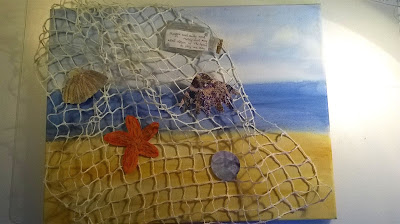It is three months since I last posted on my blog, so I feel it necessary to recap.
I came back from Summer School in July all fired up and keen to proceed with the final push of this Module. My best of intentions were derailed by helping two lots of friends pack up and move house, a succession of minor assorted bugs and viruses, major house refurbishment, visitors and more illness. I completely lost my direction, enthusiasm and energy.
However I'm now fit as a flea and my get-up-and-go seems to have crept back home. My former studio is now a downstairs bedroom all ready for a disabled guest who is coming to stay for a few days, as well as (hopefully not too much later) for Moray when he has the hip replacement surgery that his doctor says is necessary. One of the upstairs bedrooms is now my new studio with a pleasant view of the garden and thanks to IKEA, plenty of storage and work areas. I'm now back in harness and ready to proceed.
 |
Former bedroom, now studio
|
 |
| Former studio, now bedroom |
To recap, I am interpreting a poem by ee cumming:
'maggy
and milly and molly and may'
maggy and milly
and molly and may
went down to the
beach(to play one day)
and maggie
discovered a shell that sang
so sweetly she
couldn't remember her troubles,and
milly befriended
a stranded star
whose rays five
languid fingers were;
and molly was
chased by a horrible thing
which raced
sideways while blowing bubbles:and
may came home
with a smooth round stone
as small as a
world and as large as alone.
For whatever we
lose (like a you or a me)
its always ourselves
we find in the sea
e
e cummings
My plan is to make a book for each of the four girls, shaped as the object each one found on the beach. The books will be caught in a fishing net, with the first and last verses as messages in bottles, also caught in the net.
 |
| 4.11.FS 1 |
My first task was to decide how to make the net. I thought of four different methods I could use to make the net:
(1) Russian Drawn Thread Ground, where threads are withdrawn and the remaining bars overcast. This could be worked in a very open fashion.
 |
| Mary Thomas's Embroidery Book |
(2) Using the technique of "gloop" from summer school. A mixture of PVA and cellulose would be painted onto a black bin liner and then threads and pieces of fabric could be laid on the gloopy surface with more gloop added. Once dry, the adhesive would have fixed the threads in place and the whole network could be peeled off the black plastic.
 |
| 4.11.FS 2 An example of a gloop structure now applied to a painted background |
(3) Crocheting a mesh using thin string and a large crochet hook to make a very open structure.
(4) Researching and trying genuine netmaking techniques.
The first one I tried was the Russian Drawn Thread Ground. I first bleached a piece of window-cleaning scrim then withdrew threads - withdrawing 16 and leaving 4 each time. I then used the withdrawn threads to overcast the bars. I was so delighted with the appearance and fragility of the resulting structure that I decided to settle for that method instead of trying the others. As well as being satisfying because it used the techniques covered in this module, the delicacy and fragility seemed to me to echo the emotional state of the girls in the poem.
 |
| 4.11.FS 3 fishing net |
I'm currently still working on the fishing net as it is time-consuming work. To save getting too bored and risking getting bogged down again, I've decided to spend half an hour every day stitching at the net until it is finished. (It's more than half-way now!) In the meantime I'll also work in parallel on something more exciting.
Today I started working on ideas for the covers of the four books. I started with May's book " a smooth round stone as small as a world and as large as alone". Today I painted some paper in stone type colours, using some metallic paint and irridescent medium. I hope to make 3-D covers for front and back by layering successively small round pieces to build up a dome shape to represent the stone.
 |
| 4.11.FS 4 stone coloured papers |
I have been worrying a lot about losing track while being unable to do anything about it. It is good at last to have the time, a space to work and most of all, my energy and enthusiasm back.




















































